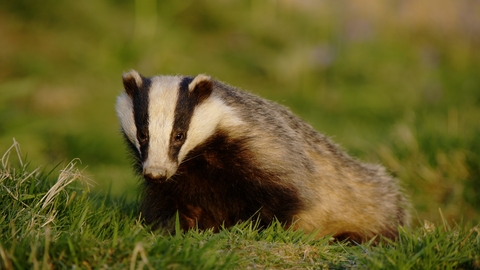
©Mark Davison
European badger
Scientific name: Meles meles
Badgers are the UK’s largest land predator and are one of the most well-known British species. They are famed for their black and white stripes and sturdy body, using their strong front paws to dig for food and to perfect their hobbit-like burrows, called ‘setts’.
Top facts
Category
Stats
Length: 75-100cmTail: 15cm
Weight: 8-12kg
Average lifespan: 5-8 years
Conservation status
Protected in the UK under the Protection of Badgers Act, 1992, and the Wildlife and Countryside Act, 1981.
When to see
January to DecemberAbout
The black-and-white striped badger is a well-known species in the UK. It is our largest land predator feeding on small mammals, birds’ eggs, worms, fruit and plants. Badgers live in large family groups in burrows under the ground called a ‘sett’. You know if a sett is lived in as it is usually neat and tidy with clean doorways marked with piles of used bedding made up of dry grass and leaves. There will also be a particularly smelly pit nearby that the badgers use as a toilet! They have strong front paws, which they use to dig for food. Cubs are born in January or February but spend the first few months underground only coming out in spring when it is a little warmer.What to look for
An unmistakable animal, the badger is large and grey, with a short, fluffy tail, black belly and paws, and a black-and-white striped face.Where to find
Found throughout England, Wales, Scotland (except for the far north) and Northern Ireland. Absent from Scottish islands, the Isle of Man, the Isles of Scilly and the Channel Islands.Did you know?
Badgers can eat several hundred earthworms a night! They are also one of the only predators of hedgehogs - their thick skin and long claws help them to get past the vicious spines. If food is in short supply, badgers will forage during the day, as well as at night. If there are badgers nearby, you can tempt them into your garden by leaving unsalted peanuts out - a tasty snack for our striped friends.The Wildlife Trusts believe that the scientific evidence available does not support a cull as it would not decrease incidences of bTB transmission from badgers to cattle. Instead it would simply disperse badger populations to the detriment of the countryside. Instead, we are urging for vaccinations against bTB to be the way forward.
Watch
Russell Savory
